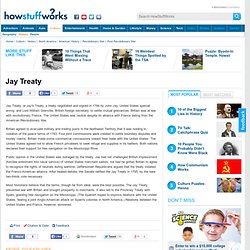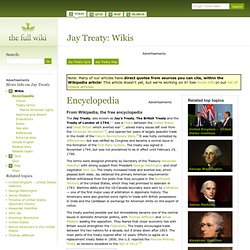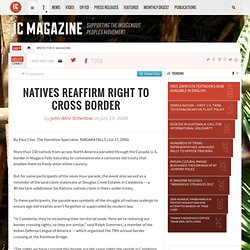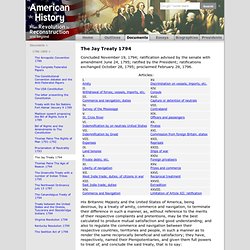

Embassy of the United States Ottawa, Canada. Jay Treaty" Jay Treaty, or Jay's Treaty, a treaty negotiated and signed in 1794 by John Jay, United States special envoy, and Lord William Grenville, British foreign secretary, to settle mutual grievances.

Britain was at war with revolutionary France. The United States was neutral despite its alliance with France dating from the American Revolutionary War. Britain agreed to evacuate military and trading posts in the Northwest Territory that it was holding in violation of the peace terms of 1783. Four joint commissions were created to settle boundary disputes and money claims. Britain made some commercial concessions toward freer trade with the United States. Jay Treaty. From Wikipedia, the free encyclopedia The Jay Treaty, also known as Jay's Treaty, The British Treaty and the Treaty of London of 1794,[1] was a treaty between the United States and Great Britain which averted war[2], solved many issues left over from the American Revolution[3], and opened ten years of largely peaceful trade in the midst of the French Revolutionary Wars.[4]It was hotly contested by Jeffersonians but was ratified by Congress and became a central issue in the formation of the First Party System.

The treaty was signed in November 1794, but was not proclaimed to be in effect until February 29, 1796. The terms were designed primarily by Secretary of the Treasury Alexander Hamilton with strong support from President George Washington and chief negotiator John Jay. The treaty increased trade and averted war, which pleased both sides. Issues Treaty terms Native American rights Approval and dissent Evaluations "No one would venture on its merits to defend it now. Notes. BORDER: Native American leaders seek to protect border rights under new security rules » Local News » Niagara Gazette. Native American leaders from the U.S. and Canada gathered near the entrance to the Rainbow Bridge on Monday to voice concerns about the potential impact of new security rules on their rights to “free passage” between the two countries.

Members of the National Congress of American Indians took a break from their 2009 mid-year conference which is being held this week in Niagara Falls to rally support for an improved dialogue between Native American leaders and officials in charge of setting border-crossing standards for the U.S. and Canada. “We cannot let them deal with it nation to nation,” said Joe Garcia, president of the National Congress of American Indians. “We are also nations and we have got to be part of the solution. That’s what we’ve been pushing all along is that the solution for Indian countries, we have to drive those solutions.”
Natives reaffirm right to cross border. By Paul Choi.

The Hamilton Spectator. NIAGARA FALLS (Jul 17, 2006) More than 150 natives from across North America paraded through the Canada-U.S. border in Niagara Falls Saturday to commemorate a centuries-old treaty that enables them to freely enter either country. But for some participants of the noon-hour parade, the event also served as a reminder of the land claim stalemate at Douglas Creek Estates in Caledonia — a 40-hectare subdivision Six Nations natives claim is theirs under treaty. To these participants, the parade was symbolic of the struggle all natives undergo to ensure age-old treaties aren’t forgotten or superceded by modern law. “In Caledonia, they’re reclaiming their territorial lands.
“The rights we have crossing this border are the same rights the people in Caledonia are entitled to as well. This right was restated in the 1952 U.S. “This is a march that brings awareness of Indians. Despite the tight security, no major incidents or delays were reported. pchoi@thespec.com. NATIVE AMERICAN FREE PASSAGE RIGHTS UNDER THE 1794 JAY TREATY: SURVIVAL UNDER UNITED STATES STATUTORY LAW AND CANADIAN COMMON LAW. The Jay Treaty 1794 < 1786-1800. Concluded November 19, 1794; ratification advised by the senate with amendment June 24, 1795; ratified by the President; ratifications exchanged October 28, 1795; proclaimed February 29, 1796.

His Britannic Majesty and the United States of America, being desirous, by a treaty of amity, commerce and navigation, to terminate their difference in such a manner, as, without reference to the merits of their respective complaints and pretentions, may be the best calculated to produce mutual satisfaction and good understanding; and also to regulate the commerce and navigation between their respective countries, territories and people, in such a manner as to render the same reciprocally beneficial and satisfactory; they have, respectively, named their Plenipotentiaries, and given them full powers to treat of, and conclude the said treaty, that is to say: Who have agreed on and concluded the following articles: ARTICLE III.
(explanatory article) ARTICLE V. ARTICLE XII. Jay's treaty. SELECT LIBRARY. Jay Treaty (United States-Great Britain [1794]